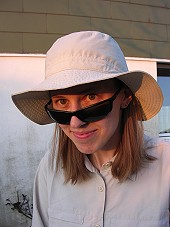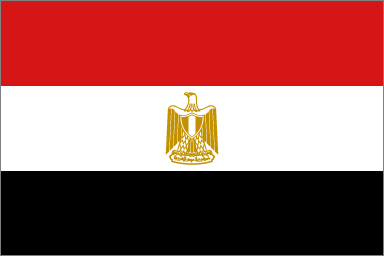
MARTINA'S WORLD TRIP
EGYPT: April 25 - May 18, 2004


(Übersetzungshilfe)
 |
MARTINA'S WORLD TRIP EGYPT: April 25 - May 18, 2004 |
|||||||
 |
||||||||
 |
Your Dictionary
(Übersetzungshilfe) |
|||||||
| Monday, May 10th, 2004 - Western Desert | |||||||
| Monday, May 10th, 2004 Western Desert (Happy Birthday, Laura!)
Today the second part of our tour started. Of our ‘old group’ only Andrea, Damian, Sarah and I had booked this part of the trip. We were joined by Neal, an ex-banker from New Zealand who gave up his job and sold his house in order to travel. (I think we were both quite glad to meet someone who did something equally crazy.) We met for breakfast at 7:30 and received our briefing by Vincent before getting on the bus at 8:00 to start our ride towards the Western Desert. As we were less people now, it was a small bus and would become some sort of our home for the coming week. Apart from Vincent, we were accompanied by Ahmed, our driver, and Atif, an Egyptian guide that was required by law to join foreign tourist groups. On the way to the desert we stopped at three different sights in order to ‘break up’ the day on the bus as Vincent said. Our first stop was at Wadi Natrun, about 100 km northwest of Cairo. Wadi Natrun was of great importance to ancient Egyptians because this was where they found natron, which was used in the mummification process. Nowadays, the valley is strongly connected with the Coptic Church that split from the Orthodox Church of the Byzantine Empire. The desert has long been the protector of faith as it was here in Wadi Natrun that thousands of Egyptian Christians retreated to escape Roman persecution in the 4th century AD. They lived in caves or built monasteries, and developed the monastic tradition that was later adopted by European Christians. Of the 60 monasteries once scattered over the valley, only four remain. One of them is St. Bishoi monastery, which is the one we visited. It is built around a church and includes a fortified keep that can only be entered over an ancient drawbridge and can hold provisions for a year. When we arrived we first visited the church. Inside, some monks were singing their prayers. The Copts actually have their own language that has its origins in several Egyptian hieroglyphs and ancient Greek. Nowadays, the Coptic language is still used in religious ceremonies and is believed to be the closest living language to the ancient language of pharaonic times. What struck me about the church was its simplicity. It was a simple stone building with hardly any decoration or ornaments. No gold, no statues, not even benches, just carpets to sit on, bare brick walls and only very few pictures of Maria and Jesus. This church had absolutely nothing of the overloading pomp in Christian churches I have seen in Europe. Later on, when we were guided by a monk to see the rest of the monastery, I asked him if there was a reason for this. He smiled and said: “According to the Coptic belief, we do not need such things to worship God. It is not the outside glory of a church that shows our dedication. It is what we feel inside that counts.” I couldn't agree more. The monk was a very nice and friendly man. He lived in the monastery for 13 years and you could feel that he was in peace with himself. He patiently answered all our questions and was a great guide. One of the things he explained that surprised me most, were the 3 conditions a man has to fulfil before he can become a Coptic monk: He has to have completed a non-clerical education, he has to prove that he can succeed in ‘ordinary’ life outside church, and he has to have completed his military service (!) which is obligatory for every man in Egypt. Although I very much like the second point and think that the ability to manage ‘normal life’ should be required from anybody before dedicating their life to God in order to advise others on how to deal with their worldly problems, I wonder how a monk can possibly go to the military! In addition to the church, we visited an ancient olive press, the part of the monastery where the hermits used to live before too many tourists made them move into the desert, and the keep where people hid when the monastery was attacked. The only way in and out of the keep is over an original wooden drawbridge that is in use for many centuries. It felt like in a different life to climb the stairs and enter this ancient building. At the end of the visit, we all agreed that St. Bishoi was a very special place whose warm and peaceful atmosphere was touching. The second stop of the day was at the Commonwealth War Cemetery of El Alamein. Those of you who paid a little attention in History, might remember that Northern Africa was the scene of a decisive Allied victory over the Axis powers during World War II: In June 1942 the German General Erwin Rommel, nicknamed the ‘Desert Fox’, launched an attempt to push his troops and 500 tanks all the way through the Allied lines to Alexandria and the Suez Canal. The Allies, however, under the command of General Montgomery stopped their advance with a line of defence stretching southward from El Alamein to the Quattara Depression. On 23 October 1942, Montgomery's 8th army swooped down from Alexandria with a thousand tanks and within two weeks routed the German and Italian forces, driving Rommel and what was left of his Afrika Korps back to Tunis. More than 80.000 soldiers were killed or wounded at El Alamein and the subsequent battles for control of North Africa. Three massive cemeteries with thousands of graves are a moving reminder of the war. At the Commonwealth War Cemetery 7000 tombstones cover a slope overlooking the desert battlefield of El Alamein. Soldiers from the UK, Australia, New Zealand, France, Greece, South Africa, East and West Africa, Malaysia and India who fought for the Allies lie here. The place is sadly impressive and I was very touched by the few personal lines engraved on each tombstone and by those who covered a body that could be identified. The third and last stop today was at the German War Memorial, about 7 km west of El Alamein. Vincent said that it wasn't a regular stop but since I was on the tour he asked if I was interested to go. I was. The memorial doesn't look especially nice from the outside and it is basically nothing but a huge monument with nameplates on the wall of all the Germans who died here during World War II. I searched them for names I knew but lucky enough, I didn't find any. Nevertheless, I was moved by this piece of history that reminded me of my cultural heritage. Both my grandfathers served in the war and although both of them survived, I knew enough horrible stories about the terror of that time. The memorial was guarded by a man who, once he found out that I was German, asked me if I had lost anyone in the battles of El Alamein. I told him that I didn't know for sure, so he gave me a big book that listed alphabetically all the names of fallen German soldiers which was easier to search than the nameplates on the wall where the names were sorted by region of origin. I looked up some names that I had in mind but found none of them. Still, all the names in this book stirred up my emotions. All these people had had lives and family before they were killed in a terrible war far away from home. Now they were nothing more but a name amongst many others engraved on the wall of a memorial. It seemed like the guard was encouraged by my interest and obvious feelings for the place. Not only did he offer me a free postcard with pictures of all WW II memorials in Northern Africa but he also asked if I wanted to “see the cave”. Warned by extensive caution notes in my travel guidebooks, I wasn't exactly sure if I should accept his invitation but then I asked Vincent to come with us. The others had all returned to the bus already, so just the two of us plus Atif followed the man into the basement of the memorial. He lit a torch, as this was the only light available down here. We descended a stairway and had to climb through a small door before entering the narrow passage that led to the cave. Whatever we had expected, what we saw was amazingly simple and yet shocking: hundreds of small cases that looked like oval tubes were stapled one on top of the other. They were navy green, about 50 cm long and had a white number written on each of them. One of them was open and the guard showed us the contents: human bones. This was all that remained of soldier number 4725 whose name was listed upstairs somewhere on the wall and in the book. Down here, laid hundreds of skeletons in their military cartouche to rest in peace. After the visit at the memorial, we continued to Marsa Matruh, a small town on the Mediterranean coast, where we arrived at the end of the day. We had dinner in a small local restaurant and it was one of the best yet the cheapest food we ever had on the entire trip! The night we spent at the Riviera Palace Hotel, also the best hotel we stayed at so far. Sarah and I even had a tiny balcony with sea view! Outside the summer season Marsa Matruh is like sleeping Cinderella, waiting for the tourists to come and kiss her awake - in other words it was pretty much a dead city. But thanks to the food and hotel I have some very good memories of this place. |
|||||||